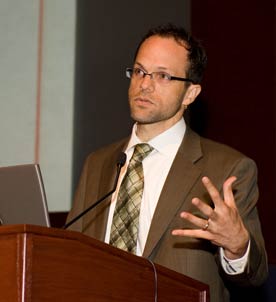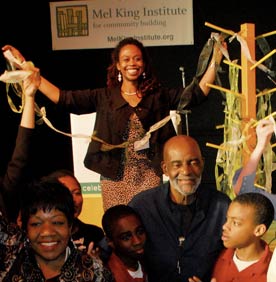When were you asked to stay on board post-Inauguration?
As we neared the completion of the work, in early December, I got a call saying there’s a key portfolio that needs to be filled at the Office of Management and Budget. It oversees HUD, Treasury, Commerce, SBA, DOT, DOJ, Homeland Security, and a host of independent agencies — the financial regulators, even the US Postal Service. I got a call from Peter Orszag’s chief of staff, and I was encouraged by respected colleagues to seriously consider this. I had not thought of OMB, specifically, as a place to work. I knew it by reputation and from interactions I had with OMB when I served at HUD a decade ago. But I ended up meeting with Peter, and with his deputy, Rob Nabors, a few days before Christmas.
We talked about this portfolio and their hopes. And about a week later, I got the call, “We’d love you to join if that’s still of interest to you.” And I was thrilled about that, and thrilled to take this on. It is a very, very broad portfolio, so the concerns and the issues at the heart of Shelterforce and of the field, this portfolio touches in 100 different ways.
It does connect to some other things that are less at the heart, I would say, of the magazine but are, at the end of the day, also community concerns more broadly defined and very relevant to community development.
An example would be the National Oceanic and Atmospheric Administration. NOAA’s the federal government’s lead for coastal zone management, and it’s going to become increasingly important with climate change and climate adaptation — kind of a large-scale community development challenge, in a lot of ways. It connects to economy, livelihood, culture, public and private relationships, financial and otherwise.
Another example would be border security, given the concerns along border towns, and really transnational concerns, right, a bi-national set of concerns about safety in particular places and the flow of arms, drugs, human smuggling. Crime and security are so central to how places develop, where dollars need to go, and so on. Again, these are community development issues, broadly defined.
And as for my portfolio, those are in addition, of course, to the big questions in housing policy, the big questions for any anti-poverty agenda, access to the middle class, green jobs, the reauthorization of surface transportation — federal investments in roads, transit, and other options — and on and on.
OMB has been terrific. Not only do we work with a very energized cabinet, but we’re united behind a reform-minded president; a president who cares about good management, better coordination, reform.
In addition, we’re able to nudge where we don’t see that happening.
Nudge how?
We have such a central role, given all the different things that OMB does, to influence the agencies and work with them and help them up their game. The role of OMB is very broad.
In post-Katrina Gulf Coast redevelopment housing, schools, health, jobs all needed to be dealt with simultaneously. What are the lessons from such large-scale and urgent community development work?
It is inter-agency at the federal level, done right. It is inter-governmental, and there are real challenges to making the federal government a better partner and making federal programs effective when their impact is highly dependent on what states and localities decide to do.
These are such extraordinary times. It’s not just that the president has an electoral mandate and that we’ve inherited massive problems. It’s that the country is in a real fiscal hole, and we take this very, very seriously. There’s obviously a lot of demand for expanded investment, not just new approaches to investment.
We are going to be under more and more pressure to show what federal taxpayer dollars are really buying — not just what issues they are addressing, numbers of people they serve — but concrete outcomes. We have to act quickly and we have to be careful at the same time.
But politics often muck up things, and while a thoughtful leader intends to lead long-term, the reality is election cycles force you to think very short-term.
We’ve seen quite a few states, cities, and small towns step up and recognize the uniqueness of this moment, and this administration has conversely recognized the very high expectation the public has for their tax dollars, which are extraordinary by any measure.
My last book, Democracy as Problem Solving, was about civic capacity in communities across the globe — the U.S., Brazil, South Africa, India. It was about the local leadership for change, but in ways that implicated the higher levels of government — states, the federal government. Our rules and dollars, the knowledge we invest in and disseminate, the bully pulpit — all of these things matter.
There are innovators working for constructive change, systems change, across America, and we need to empower them, understanding that change is going to play out differently from place to place.
You mentioned there was a need to create a new infrastructure of support, suggesting that CDCs and CBOs will play greater roles in achieving the administration’s objectives. What will those roles be?
Number one, the notion of flexible capacity, flexible capability at the community level cuts both ways. On one hand, I think most of us are conscious of how flexibility and adaptability by CDCs is a tremendous plus. They were essentially born to fill in all sorts of gaps and to take on whatever was most important and to respond to community will, and that’s the best of the community development movement in so many ways.
On the other hand, such flexibility makes it harder for those outside the field to recognize what you are, to understand what you’re really good at, and how they should invest in you in a way that leads to clear results. And it does raise the competition question: Are there others out there that are perhaps more specialized, who can claim to be better than a CDC at some important task?
Anything you can do to help make a stronger, more complete, more evidence-based case of the comparative advantage of the accomplishments of CDCs in areas that are clear national priorities is essential. It’s a range of areas that includes clean energy, sustainability, wellness and better health outcomes — reducing costs, improving outcomes in health — tackling poverty as the economy continues to change, helping young people make safer choices, creating more avenues to the middle class.
I think we need to sharpen that case. With so many competing claims on resources, I think we need to stick at that work and answer those questions.






Comments